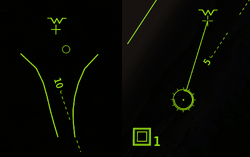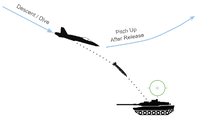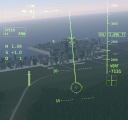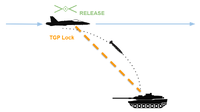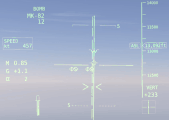Weapon Guidance
This page describes the guidance systems of weapons in VTOL VR as well as how they function.
An important part of how air-to-air missiles can reliably achieve hits is their ability to lead ahead of its target to intercept where they will be based on their trajectory. This is more efficient for engaging targets farther out, as the missile will have to make less course corrections thus retaining some of its speed.
Other guidance types like laser homing use pursuit navigation, where the weapon points exactly to where the target is. It is incapable of leading fast-moving targets, making it useless against aircraft but serving as a relatively cheap guidance option for simpler air-to-ground munitions.
Infrared Homing
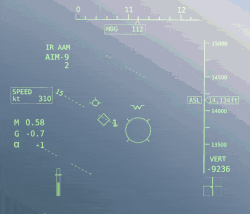
Aircraft engine exhausts put out massive amounts of heat, especially in afterburner, thus emit a lot of infrared radiation. Infrared homing (IR or just heat seeking) missiles have a seeker head that locks onto and tracks these IR signatures to guide itself toward the target. Infrared homing has a limited range, at most 10 miles, and is vulnerable to flares which burn intensely for a brief time.
The older generation of IR missiles like the AIM-9E are considered rear-aspect missiles, as they can only see IR radiation if pointed directly at the target's rear where the engine exhausts are directly visible. Modern IR missiles have more sensitive seekers that make them all-aspect, and can lock onto heat signatures regardless of the target's orientation.
When selected, the missile's seeker emits a tone of varying pitch according to the temperature of whatever it's looking at. When aimed toward a sufficiently hot object, the growl transitions to a whine along with a steering dot appearing on the HUD, indicating a good tone and the missile is ready to fire.
Exercise caution when using IR missiles in proximity to allies, as they are indiscriminate in whose heat signatures to lock onto and launching has no form of IFF. If a teammate flies in front of the seeker, there is a chance the missile may switch targets and result in friendly fire.
Semi-Active Radar Homing
Semi-Active Radar Homing (abbreviated SARH) is an older form of guidance that relies on the launch platform's radar to illuminate a target while the missile's antenna homes in on the reflected radio waves.
SARH missiles require a continuous Single Target Track lock on the target from launch until impact. If the lock is broken, the missile will be lost. In the case of the AIM-7, a target can be reacquired if the target is still within field of view of the antenna.
Active Radar Homing
Active Radar Homing (ARH) missiles rely on the launch platform's radar returns for guidance updates during its initial cruise stage, before switching to its internal radar once within range. The missile receives course corrections mid-flight every time the host radar sweeps their target. Once the missile finds a target, it will go "pitbull" and guide itself with its own radar. ARH missiles can be fired either from a STT lock, or Track While Scan where up to 4 targets can be locked and tracked simultaneously.
Unlike SARH, active homing missiles do not have a reacquire ability in either STT or TWS. If radar lock is lost, they will "go dumb" and continue towards its last intercept point until they pitbull or self-destruct.
Similar to IR missiles, exercise caution when firing ARH missiles with allies in pitbull range. Once a missile goes pitbull it will lock onto any target whether friend or foe.
Active Radar Homing (DataLink)
The AIM-120D has the unique capability of providing initial guidance through DataLink communication between aircraft and missile. The advantages this form of guidance provides are twofold: the target does not receive any direct warning of the incoming missile until pitbull, and the launching aircraft can immediately make evasive maneuvers after launch without losing lock.
The TSD is primarily used to lock and fire, but may also be fired directly from the RADAR page if desired.
DataLink sources include:
- Radar returns (self)
- Radar returns from allies and/or AWACS)
- RWR contacts (self and from ADM-160J decoys)
- TGP/EOTS lock on an enemy (self or allies)
- Passive proximity sensors
MADDOG
Active Radar missiles can configured to fire in MADDOG mode, which does not require any radar lock before firing.
In this mode, the missile flies straight ahead and continuously searches for a target with its internal radar, pitbulling on the first target it acquires. It will not loft to gain altitude like during a launch with a radar lock.
Home-on-Jam
Both Active and Semi-Active missiles have the ability to fire in Home-on-Jam (HOJ) mode. Using noise analysis, the launching aircraft can triangulate the approximate elevation and azimuth (direction) of the jamming source and guide the missile roughly towards it.
If the missile's radar burns through, it will immediately pitbull on the target. If the noise jamming ceases, it will resume flight in MADDOG mode until it pitbulls or self-destructs. The AIM-120C will automatically enter HOJ mode if it encounters noise jamming after launch.
Anti-Radiation Homing
Anti-radiation missiles (ARM) use a passive radar homing antenna to detect and guide toward radar-emitting sources like SAM radar sites, effectively functioning like a fire-and-forget missile. While the missile is in-flight and receives more radar pulses, it triangulates the target's position and calculates a more accurate solution as it gets closer to the radar source. ARMs require a radar emission source to be locked with the ARAD or TSD before they can be fired.
Some ARMs are equipped with an inertial navigation system (INS) for back-up guidance if the threat radar shuts off its transmitter, usually from a nearby Missile Warning Radar. This comes with its own issues: missiles a considerable distance away will experience INS drift that will gradually lead them off-course from their intended target. A Decoy Radar Transmitter may also trick ARMs into switching to a phoney target, sacrificing itself to keep the SAM radar operational.
Optical Guidance
Optical guidance is usually utilized on air-to-ground missiles (AGMs). Their seeker head uses an electro-optical contrast sensor slaved to the Targeting Pod to lock onto a target and keep it in view after launch. This allows the missile to accurately track and lead ahead of moving targets. Optically guided munitions are fire-and-forget, as all course corrections are done automatically by the missile.
Due to the nature of optical sensors, effective range of missiles is roughly limited by the locking range of the targeting pod. Note that optically guided munitions require an unobstructed line of sight to the target at all times; obstacles like terrain, trees, or buildings may break the missile's lock on its target. Cloud cover can also prohibit the targeting pod from acquiring a lock.
More advanced weapons have a LOAL functionality: by locking a target with the targeting pod and diving behind cover, the missile will loft itself to clear the terrain and seek out the nearest target to that point.
Laser Guidance
Laser guidance is used on bombs, missiles, and rockets alike. The aircraft designates a target using the Targeting Pod laser, and the munition's seeker tracks the reflected IR radiation from the target. Once the targeting pod locks on to something the laser automatically turns on; the visible IR laser activated by the MARK button does not affect the targeting laser.
Great care should be taken while maneuvering and lasing a target, as exceeding the gimbal limit of the targeting pod cam break the lock and bring the weapon off-target. Laser/Seeker can be set with the Up-Front Console, meaning another aircraft or even a JTAC (Joint Terminal Attack Controller) can "buddy-lase" a target. The releasing aircraft and supporting ally must use the same Laser and Seeker code respectively; if done correctly the laser can be seen through the targeting pod as a green diamond and the munition will automatically lock onto the target. Some optically guided weapons feature a dual optical/laser guided LOAL mode, functioning in a similar way.
Buddy Lasing
Work in progress...
SACLOS Guidance
Work in progress...
GPS Guidance
GPS guided weapons rely on GPS signals to guide towards a specific point in the world. When the weapon is released, the control surfaces deflect to glide towards that point and make adjustments to keep it on target. Munitions like cruise missiles and air-launched decoys can use a list of GPS points to navigate along a path to, for instance, crest a hill or glide through complex terrain.
The AGM-161 and AGM-89 use other systems in conjunction with GPS: both use a high-frequency radar for terrain following/avoidance. The AGM-161 uses infrared imaging for terminal guidance to a target closest to its last GPS point, while the AGM-89 turns on a forward-facing radar for identifying naval ships.
Unguided
Guns
Aircraft cannons have a context-sensitive aiming system.
By default the cannon with use the funnel gunsight to give a rough path of where rounds will go. The idea is a hit is guaranteed when the enemy aircraft's wings fit within both sides of the funnel. There is also a ground circle reticle that show roughly where the rounds will impact when aiming at the ground.
When locked onto a target with the radar, TSD, or Targeting Pod, the cannon will switch to the pipper gunsight that factors in the trajectory of the locked target and displays a more accurate reticle.
The M230 chaingun uses the TGP crosshairs as its reticle when in its gimbal mode.
Rockets
Dumb-fire rockets use a ground circle reticle to display its predicted impact point, or a pipper if locked on with the targeting pod.
Bombs
Free-fall bombs use two different systems to determine its predicted impact point:
CCIP (Constantly Calculated Impact Point) uses the aircraft's current velocity and altitude (as well as wind conditions if enabled) to calculate where bombs will land, shown by the pipper reticle.
Bombing runs with CCIP are typically done in a direct attack fashion: pitching down into a slight descent and maneuvering the pipper over the target before releasing. An alternate method is using the targeting pod's PIP mode and releasing when the crosshairs are over the target.
CCRP (Constantly Calculated Release Point) activates when locked on with the Targeting Pod or TSD, and factors in ranging and target trajectory information (if it is moving) into the release point.
CCRP adds a dashed solution line to the HUD that indicates where to steer, as well as a release cue (diamond) and release bracket (carats). When the solution and drop lines coincide, wait until the the cue is between the brackets before dropping. If configured in the CCRP AUTO mode, holding down the trigger will automatically release at the exact time the two elements align.
This mode can prove to be very useful for high speed, high altitude, high precision bombing against preplanned targets while remaining well outside engagement range of short range air defenses or anti-aircraft artillery.

